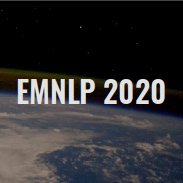SapienzaNLP @ EMNLP 2020
4 + 1 papers at EMNLP 2020 by our group!
 We are proud to announce that SapienzaNLP has 4 + 1 papers accepted at EMNLP 2020: 4 long papers at the main conference and 1 demo paper. Our contributions touch several areas from Word Sense Disambiguation to Semantic Parsing and Semantic Role Labeling.
We are proud to announce that SapienzaNLP has 4 + 1 papers accepted at EMNLP 2020: 4 long papers at the main conference and 1 demo paper. Our contributions touch several areas from Word Sense Disambiguation to Semantic Parsing and Semantic Role Labeling.
With More Contexts Comes Better Performance: Contextualized Sense Embeddings for All-Round Word Sense Disambiguation
by Bianca Scarlini, Tommaso Pasini and Roberto Navigli
ARES is a new method to produce contextualized embeddings for all the concepts in WordNet that achieve high performance both in the Word Sense Disambiguation and Word-in-Context tasks. Moreover, by relying on English data only, we provide unified representations of meanings across languages that attain state-of-the-art results on the 4 European languages available in the multilingual Word Sense Disambiguation task, and can be potentially applied to all 100 languages supported by both BabelNet and multilingual BERT.
Generationary or: “How We Went beyond Word Sense Inventories and Learned to Gloss”
by Michele Bevilacqua, Marco Maru and Roberto Navigli
Dictionaries are slow-changing beasts. What if you run into some unusual expression that they do not cover?
Generationary is a neural seq2seq model which contextualizes a target expression in a sentence by generating an ad hoc definition. Our work is a unified approach to computational lexical-semantic tasks, encompassing state-of-the-art Word Sense Disambiguation, Definition Modeling and Word-in-Context.
Thanks to Generationary, you can finally get to know what your friends meant when they called you a “sci-ficionado”! And what are those “sharks of Wall Street” anyway?
XL-AMR: Enabling Cross-Lingual AMR Parsing with Transfer Learning Techniques
by Rexhina Blloshmi, Rocco Tripodi and Roberto Navigli
Over the years, research on Abstract Meaning Representation (AMR) has mainly focused on English without many advances across languages. XL-AMR is a SotA cross-lingual AMR parser that exploits the existing data in English to transfer semantic representations across languages. Our work sheds light on the applicability of AMR as an interlingua and sets the state of the art in Chinese, German, Italian, and Spanish cross-lingual AMR parsing. Furthermore, a detailed qualitative analysis shows that XL-AMR can overcome common translation divergences among languages.
InVeRo: Making Semantic Role Labeling Accessible with Intelligible Verbs and Roles
by Simone Conia, Fabrizio Brignone, Davide Zanfardino and Roberto Navigli
InVeRo is our latest system demonstration in collaboration with Babelscape. The last few years have witnessed numerous advancements in the area of Semantic Role Labeling (SRL), but ready-to-use systems have struggled to keep up with this progress. This demo provides a web-based platform for SRL to make it more accessible to a wider audience. Users can perform SRL on the fly with a state-of-the-art BERT-based model without writing a single line of code! For more demanding users, InVeRo also provides easy-to-use REST APIs. Feel free to check out InVeRo at http://nlp.uniroma1.it/invero.